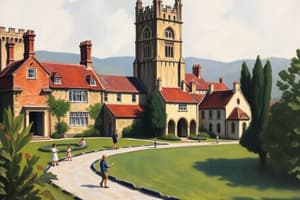Podcast
Questions and Answers
What medium has been an essential means of recording history since prehistoric times?
What medium has been an essential means of recording history since prehistoric times?
- Dance
- Sculpture
- Painting (correct)
- Music
During which century did the invention of the printing press by Johannes Gutenberg occur?
During which century did the invention of the printing press by Johannes Gutenberg occur?
- 12th century
- 18th century
- 14th century
- 15th century (correct)
Which style of painting focused on capturing light and emotion rather than realistic representation?
Which style of painting focused on capturing light and emotion rather than realistic representation?
- Impressionism (correct)
- Cubism
- Baroque
- Renaissance
What invention allowed for mass production of books, making them more accessible to the public?
What invention allowed for mass production of books, making them more accessible to the public?
Which type of book provides perspectives on past events from different viewpoints?
Which type of book provides perspectives on past events from different viewpoints?
How do paintings, buildings, and books help us understand history?
How do paintings, buildings, and books help us understand history?
What do buildings serve as according to the text?
What do buildings serve as according to the text?
Which historical examples are mentioned in the text to showcase engineering marvels?
Which historical examples are mentioned in the text to showcase engineering marvels?
What power dynamics do medieval castles and cathedrals illustrate according to the text?
What power dynamics do medieval castles and cathedrals illustrate according to the text?
How have castles evolved over centuries, as per the text?
How have castles evolved over centuries, as per the text?
What is one intriguing aspect of architectural history mentioned in the text?
What is one intriguing aspect of architectural history mentioned in the text?
Which element is not associated with buildings according to the text?
Which element is not associated with buildings according to the text?
Flashcards are hidden until you start studying
Study Notes
History
The study of history is concerned with interpreting past events through various sources such as written accounts, material culture, visual media, oral traditions, and archaeological findings. It encompasses a wide range of disciplines, including art history, cultural history, economic history, military history, political history, social history, world history, and more. In this article, we will explore three aspects of human history - buildings, painting, and books, providing you with a deeper understanding of these significant historical elements.
Building a Legacy
Buildings serve as physical representations of our collective past, revealing much about the people who built them. They reflect their architectural skills, engineering prowess, artistic styles, religious beliefs, and societal values. Some notable examples include ancient ruins like the pyramids of Egypt and the Great Wall of China, which showcase engineering marvels that have stood the test of time. Medieval castles and cathedrals demonstrate the power dynamics between secular and religious authorities, while palaces from different eras illustrate the symbolism within monarchies.
One intriguing aspect of architectural history is how structures have been repurposed over centuries. For instance, castles evolved from defensive fortresses into grand residences and even places of worship. Similarly, many churches in Europe were converted from Roman temples during the fall of the Roman Empire.
Colorful Chronicles
Painting has been an essential means of recording history since prehistoric times. From the earliest cave drawings to modern digital art, this medium has allowed artists to capture and convey stories, emotions, and ideas. Early painting techniques ranged from stylized figures on cave walls to detailed scenes on Egyptian tombs. During the Middle Ages, paintings were often used in churches to illustrate biblical stories, while in the Renaissance, artists like Leonardo da Vinci and Michelangelo produced masterpieces that continue to inspire awe.
As painting styles evolved, so did the subjects depicted. Portraits became more realistic and expressive, landscapes gained prominence, and genre scenes provided insights into daily life. The rise of photography in the 19th century led to new forms of painting, such as Impressionism and Expressionism, which focused on capturing light and emotion rather than realistic representation.
Written Records
Books have played a crucial role in the preservation and dissemination of knowledge throughout history. As early as the Sumerians, who invented writing around 3500 BCE, texts were used for various purposes, including record-keeping, religious rituals, and even entertainment. The invention of the printing press by Johannes Gutenberg in 1440 allowed for mass production of books, making them more accessible and affordable to the general public.
Historical books have taken many forms, including chronicles, biographies, histories, and memoirs. They provide perspectives on past events from different viewpoints, offering valuable insights into societal norms, cultural practices, and intellectual trends. Furthermore, historical novels and films can engage audiences in a way that traditional history textbooks cannot, bringing the past to life through storytelling.
Preserving Our Past
Understanding history helps us appreciate our cultural heritage and learn valuable lessons for the future. By examining buildings, paintings, and books, we gain a broader perspective on human civilization and its development. Each artifact tells a story, adding pieces to the vast puzzle of our collective memory. So next time you visit a historical site, admire a painting, or pick up a history book, remember that you are engaging with a piece of our shared human story.
For further reading, explore online resources such as Project MUSE, JSTOR, and Europeana, which offer extensive collections of scholarly articles, ebooks, primary sources, and multimedia content related to history.
Studying That Suits You
Use AI to generate personalized quizzes and flashcards to suit your learning preferences.




